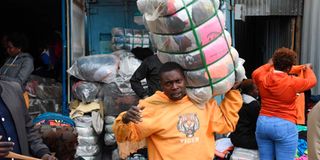Mitumba may be ‘cool’ but it’s dirty

A mitumba trader.
Mitumba, aka second-hand clothes, have offered dignity to many poor people in Africa who would struggle to afford expensive new clothes. However, this dignity is now coming at a great price to the environment.
Mitumba is an agenda in political manifestos this year, perhaps to win the votes of the poor. Nonetheless, the poor cannot be won by expensive clothes that they cannot afford.
The industries set up to manufacture new clothes will still have to be built with the environment in mind as eco-fashion is now all the rage. Even countries in the West are looking to save the environment by championing sustainable fashion.
Mitumba being a ‘dead white man’s clothes’ is a myth; although they form part of the bales destined for Africa. The disposable culture in the West has been contributing to the recent jump in mitumba exports. The demand for fast fashion in the West has been rising—and so has its impact on the environment in developing countries, where they manufacture them quickly to meet the demand.
The unsold items of clothes form a glut, which eventually end up being offloaded to Africa as second-hand clothes. Fast fashion creates a quick turnaround for shoppers, who throw away yesterday’s fashion to keep abreast of the latest styles.
Charities abroad, such as Oxfam, have been the greatest beneficiary from second-hand cloth exports although they are now one of the biggest advocates of sustainable fashion. The clothes donated to charity shops abroad find their markets largely in Africa, where the price of new clothes is exorbitant for poor people.
The trade in second-hand clothes runs into billions of dollars with US and UK leading the list of countries that export them. The clothes are also the most preferred, with many in Africa assuming that they are made in the UK or US when, in fact, their manufacturing is outsourced to China, India or Bangladesh.
Having said that, a second-hand designer top will still fetch more in Gikomba if it carries the right label. You get those through ‘camera’ selection, where a buyer gets the first preference to peruse for designer items—at a cost, of course.
The clothes that fail to sell in the second-hand cloth markets due to poor quality is what should concern Africa. Walking around Gikomba gives you an insight into how much of the unsold items affect the environment. Some of the textile materials are not biodegradable. Their impact on the waterways in second-hand clothes markets should worry us more.
Evidence in Ghana shows some of the unsold items end up in the sea. Investigations by Deutsche Welle, of Germany, found that 40 per cent of the second-hand clothes end up at “landfills and in bodies of water, polluting entire ecosystems”.
The same could be said of Gikomba, where mounds of unsold clothes are found around the market, buried in shallow graves close to the river. Kongowea market in Mombasa, which is not far from the Indian Ocean, must have its own evidence of the impact of unsold clothes on the sea.
Africa is where clothes come to die, it’s said, and perhaps where they’re buried in the ground, seas and other water bodies with harmful effects on the environment.
Mitumba may be a subject for politicians to woo votes but, without them, many poor people will struggle to afford clothes. The challenge for countries like Kenya, with a large population that still lives below the poverty line, is in balancing the need for the poor against environmental protection when it comes to mitumba. Perhaps there should be a requirement for second-hand clothes to be imported on a quota, of good quality and inspected before they arrive in the country.
Besides, the current rule that buyers only buy closed bales is a lottery and immensely contributes to the dumping of poor quality second-hand clothes. If a trader finds poor quality clothes in the bale, she/he has no option but to dump them.
The exporting countries evade the responsibility of dealing with waste from second-hand clothes by sealing them up before they are inspected. Africa does not have the capacity to recycle or process the waste and that burden should be carried by the exporting countries until a lasting solution is found globally.
Kenya has made a lot of noise around fighting plastic pollution to protect its environment but is forgetting that second-hand clothes might be causing even more damage. Banning mitumba, therefore, needs a bigger conversation.
Building textile industries is half the answer in the face of low buying power and the impact of industries on the environment. Eco-friendly industries, and recycle and reuse policies, are the best way to sustain the environment. That requires good quality clothes in the first place.
To save the environment, politicians should give mitumba more serious focus not just during the electioneering period.
Ms Guyo is a legal researcher. [email protected]. @kdiguyo





